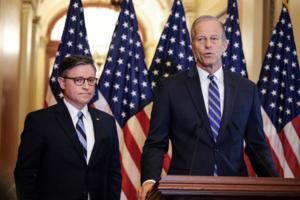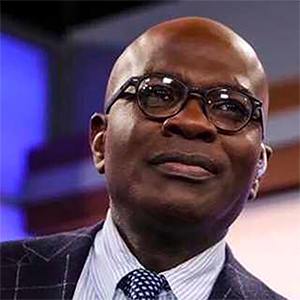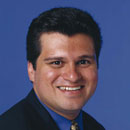Politics
/ArcaMax

Trump announces military 'warrior dividend' amid inflation woes
President Donald Trump looked to reassure Americans concerned about the rising cost of living by announcing plans to award a special holiday payment to military service members and roll out new housing reforms in the new year.
Trump announced the plans Wednesday during a prime-time address from the White House, which he used to extol his ...Read more

Trump's dark money group started 2025 with $84 million war chest
WASHINGTON — The dark-money arm of Donald Trump’s sprawling political operation entered 2025 with $84 million in the bank, highlighting the president’s fundraising prowess and offering insight into his war chest ahead of crucial midterm elections.
Securing American Greatness, a 501(c)4 organization, raised $275 million in 2024, according ...Read more

Analysis: The 2026 midterms are at a crossroads
WASHINGTON — With less than a year to go, the 2026 midterm elections are at a crossroads.
Emboldened by the 2024 election results that resulted in full GOP control of Washington, Republicans began the year on a political high, but it’s been rough going since then. President Donald Trump’s job ratings have slipped back into mediocrity, ...Read more

House panel deposes Jack Smith over Trump criminal cases
WASHINGTON — Former special counsel John L. “Jack” Smith sat for a closed-door deposition Wednesday with the House Judiciary Committee, defending his conclusion that President Donald Trump engaged in a criminal effort to overturn the 2020 presidential election, according to portions of his opening statement obtained by CQ Roll Call.
“...Read more

Jack Smith sits for closed-door grilling by GOP lawmakers over Trump probes
Jack Smith told a congressional committee Wednesday that he found proof “beyond a reasonable doubt” that President Donald Trump committed crimes as the former special counsel was expected to face harsh grilling by Republicans behind closed doors about his historic investigations.
The deposition was held in private after GOP House Judiciary ...Read more

New year, same problems for Trump with control of Congress on the line in 2026
WASHINGTON — President Donald Trump is poised to head into the new year facing several political and economic headwinds that could hamstring Republicans in the coming midterm elections.
As his poll numbers sag and a stubborn economy continues to frustrate voters, Trump is expected to depart Washington on Friday to spend Christmas and New Year...Read more

Senate votes for recognition of Lumbee, as NC tribe nears end of 137-year fight
WASHINGTON — More than 80 members of the Lumbee Tribe of North Carolina sat Wednesday in the Senate gallery watching lawmakers take a vote that was 137 years in the making.
Senators agreed to recognize the tribe and provide full federal benefits in a 77-20 vote. It’s likely that President Donald Trump will sign the bill they passed into ...Read more
Jack Smith faces closed-door grilling by GOP lawmakers over Trump probes
Former special counsel Jack Smith faced harsh grilling Wednesday by congressional Republicans behind closed doors about his historic investigations into President Donald Trump.
The deposition was held in private after GOP House Judiciary Committee lawmakers rejected Smith’s request to answer questions in public as part of their probe into his...Read more

Washington Rep. Dan Newhouse not seeking reelection
WASHINGTON — Rep. Dan Newhouse of Washington, who has beaten challengers backed by Donald Trump in the past two election cycles, is the latest House Republican to announce his retirement.
Newhouse said in a statement Wednesday that he had “no reservations or remorse” as he ends his tenure representing central Washington’s deep-red 4th ...Read more

Commentary: Donald Trump is conducting a secret war
Covert operations are nothing new for the United States. Throughout its history, the U.S. has overthrown governments it didn’t like, supported insurgencies to complicate the goals of its adversaries and organized coups to subvert politicians perceived as being hostile to American interests.
The list of examples is long: to name just a few, ...Read more

Government shutdown, reconciliation law highlight turbulent year in Congress
WASHINGTON — Five months ago, the story of the first session of the 119th Congress was expected to be the passage of President Donald Trump’s signature policy legislation known as the One Big Beautiful Bill. But that was before the longest partial government shutdown in American history and the intertwined extended absence of the House.
...Read more

Trump expands US travel ban to include two Caribbean countries
Citizens of Antigua and Barbuda and Dominica will face new restrictions on entry into the United States after President Donald Trump on Tuesday expanded a partial travel ban to include 15 new countries as of Jan. 1.
In adding the two eastern Caribbean nations to the list, Trump cited concerns about their Citizenship by Investment, or CBI, ...Read more

Trump expands U.S. travel ban to include two Caribbean countries
Citizens of Antigua and Barbuda and Dominica will face new restrictions on entry into the United States after President Donald Trump on Tuesday expanded a partial travel ban to include 15 new countries as of Jan. 1.
In adding the two eastern Caribbean nations to the list, Trump cited concerns about their Citizenship by Investment, or CBI, ...Read more

Trump expands countries with US travel restrictions
WASHINGTON — President Donald Trump added 20 countries to those facing either full or partial travel restrictions Tuesday, in a proclamation that says the U.S. must exercise “extreme vigilance” during the visa and immigration processes for national security.
The proclamation issued Tuesday added five countries and the Palestinian ...Read more

Trump weighs pressuring defense firms to cut buybacks, dividends
WASHINGTON — The Trump administration is weighing an executive order that would pressure defense contractors to spend less on stock buybacks and dividends while boosting investment in infrastructure and weapons production, a person familiar with the matter said.
The executive order, which President Donald Trump could sign as early as this ...Read more

White House defends chief of staff Wiles after tell-all profile
WASHINGTON — President Donald Trump’s chief of staff is defending herself after granting an extraordinarily candid series of interviews with Vanity Fair in which she offers stinging judgments of the president himself and blunt assessments about his administration’s shortcomings.
The profile of Susie Wiles, Trump’s reserved, influential...Read more

Wrestling legend Mick Foley parts ways with WWE because of its 'close relationship' with Trump
LOS ANGELES — Professional wrestling legend Mick Foley announced Tuesday that he is "parting ways with WWE" because of the organization's ties with fellow WWE Hall of Fame inductee President Donald Trump.
"While I have been concerned about WWE's close relationship with Donald Trump for several months — especially in light of his ...Read more

Ban Congress from trading stocks? NC Senate candidate Roy Cooper says yes
WASHINGTON — As members of Congress debate whether to ban stock trading, Roy Cooper, the former governor of North Carolina and a Senate candidate, announced his support for a ban.
“A lot of people just don’t trust Washington politicians,” Cooper said in a written statement to McClatchy. “That’s because too many of them look after ...Read more

Donald Trump Jr. is engaged, meet his fiancée Bettina Anderson
Donald Trump Jr. and Bettina Anderson are engaged.
President Trump revealed his eldest son’s engagement at a White House holiday party Monday night, as Don Jr. also opened up about the next chapter of his life.
“It’s not often that I’m at a loss for words, ’cause we usually do the ranting and raving really well, but this is a little ...Read more

California, other states sue Trump for blocking EV charging funds
California led a coalition of 16 states Tuesday to sue the Trump administration in an effort to free up billions of dollars in federal funds intended to build and repair electric vehicle charging stations that it argues the White House has illegally blocked.
Attorney General Rob Bonta said the U.S. Department of Transportation did not have the ...Read more
Popular Stories
- Kelly defiant after Pentagon escalates video investigation
- California Gov. Gavin Newsom trolls Trump with website tracking president's 'criminal cronies'
- Trump plans prime-time address Wednesday but gives no hints on topic
- Jack Smith sits for closed-door grilling by GOP lawmakers over Trump probes
- New year, same problems for Trump with control of Congress on the line in 2026




















































